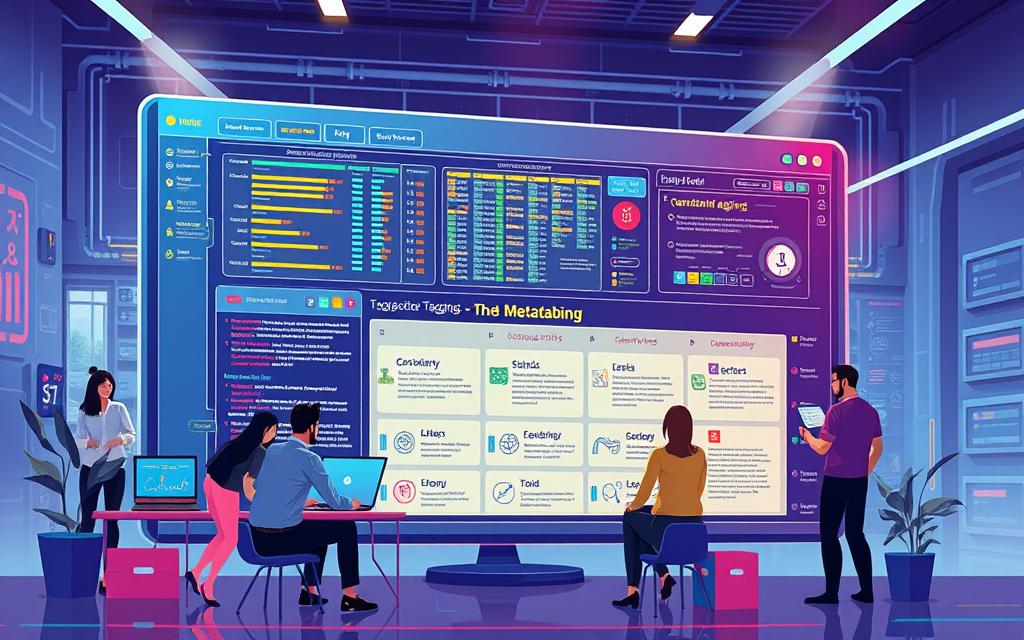Ever spent hours digging through files, only to come up empty-handed? You’re not alone. Nearly half of teams waste over an hour daily searching for assets. The solution? Metadata tagging for datasets – your GPS for navigating digital chaos.
Think of untagged files like a messy desk. Now imagine every document neatly labeled and instantly findable. That’s the power of proper digital asset management. Tools like pixx.io turn this vision into reality, whether you’re handling 100 files or 10 million.
This guide will walk you from tagging basics to AI-powered automation. Marketers, researchers, and tech teams alike will discover how to achieve searchable nirvana. Ready to transform your workflow? Let’s dive in.
What Is Metadata Tagging (And Why Should You Care)?
Lost files cost businesses $2.5M yearly—smart labeling slashes that waste instantly. Think of metadata as a file’s ID card: it tells you the creator, date, and purpose without opening it. Tagging goes further, like adding colored sticky notes to highlight key details.
Metadata Tagging vs. Metadata: What’s the Difference?
Metadata happens automatically (like a photo’s timestamp). Tagging is intentional—you assign keywords like “2023_product_launch” to make files searchable. The New York Public Library uses this to manage 800K+ digital assets. Untagged items? They become “dark data,” invisible to searches.
How Metadata Tagging Works Behind the Scenes
Tags embed in file headers or cloud records. Search algorithms scan these labels first. Tools like DAM systems automate this, but manual tagging (e.g., HTML title tags) still matters. Pro tip: AI tools can suggest tags by analyzing content, saving hours.
The Power of Metadata Tagging for Datasets
Teams that master smart labeling unlock hidden productivity goldmines daily. With 60% faster file retrieval reported by consistent users, the time savings add up quickly. Digital asset management systems take this further—cutting search time by 75%.
Turbocharge Searchability and Save Time
What used to take 30 minutes now happens in 3 clicks. Properly labeled assets let you:
- Pull up last year’s campaign visuals during meetings
- Compare budget versions instantly (2024_v3 vs 2024_v4)
- Generate audit trails for compliance reports
Marketing and legal teams especially benefit. Approved logos and contracts become accessible to all authorized users immediately.
Boost Teamwork With Consistent Tagging
When everyone uses the same keywords, collaboration soars. During mergers, tagged files integrate seamlessly. Untagged items? They create costly bottlenecks.
ROI becomes clear when you calculate:
- Hourly wages saved per search
- Reduced duplicate file creation
- Faster project turnarounds
Future-Proof Your Digital Assets
Tags preserve context when teams change. But watch for “tag decay”—outdated labels need occasional reviews. Well-maintained systems keep delivering value for years.
Next, we’ll explore the 6 essential types that power digital asset management.
6 Types of Metadata You’ll Use Every Day
Not all labels are created equal—some unlock files instantly while others gather digital dust. The right mix turns chaos into order. Here are the six most powerful categories, with real-world examples.
Descriptive: The “What” of Your Files
Think titles, summaries, and keywords. These labels answer basic questions:
- Internal codes: “PRJ_UX_2024_V3” for developers
Tip: Use Dublin Core standards like “creator” and “date” for consistency.
Structural: The “How” of Relationships
This type maps connections between files. Examples include:
- Chapter markers in podcast episodes
- Linked Excel sheets in a financial report
Administrative: The “Who Can Access” Rules
Control visibility and usage rights. Must-haves:
- GDPR compliance tags (“confidential_client_data”)
- Expiration dates for temporary assets
Bonus Types You Might Overlook
Specialized needs call for unique labels:
- Emotional: “approved_enthusiastic_tone” for brand voice
- Industry-specific: HIPAA tags in healthcare files
- Preservation: Format migration notes (e.g., “convert_PSD_to_PNG”)
| Type | Best For | Who Creates It |
|---|---|---|
| Descriptive | Searchability | Content creators |
| Structural | File relationships | Developers |
| Administrative | Security | IT teams |
Remember: Not every file needs all six. A contract might need administrative tags, while a blog image thrives on descriptive ones.
Metadata Tagging Best Practices: Pro Tips
82% of tagging fails? Avoid them with these rules. Whether you’re managing digital files or team workflows, smart labeling saves time and headaches. Follow these battle-tested best practices to make every search instant.

Think Like Your Users (Not Just Your Team)
Tag for the intern, not the director. Ask: “Would someone new understand this?” Example: “Q4_report_final_FINAL_2.pdf” fails. “2024_Marketing_Budget_v3” wins.
Run a user persona exercise:
- Who searches most? (Sales? Legal?)
- What terms would they type?
- Test tags with fresh hires—no jargon allowed.
Naming Conventions: Your Secret Weapon
Consistency cuts errors by 40%. Use this template: [Project]_[Year]_[Type]_[Version]. Example: “Rebrand_2024_Logo_v2”.
Automate where possible:
- Auto-tag by folder location (e.g., “/Clients/Amazon” → “client_amazon”)
- Add version control: “_draft” vs. “_approved”
Why Simplicity Beats Cleverness Every Time
Limit tags to 3 words max. “Social_media_post” works. “Instagram_carousel_Q2_organic_engagement” doesn’t.
Tagging Hall of Shame (real examples):
- “Presentation_that_one_time_with_Steve.pptx”
- “Important_do_not_delete_final.docx”
Checklist before finalizing tags:
- Is it search-friendly? (Try it!)
- Does it follow team rules?
- Will it make sense in 6 months?
Ready to put this into action? Next, we’ll break down the step-by-step process to tag like a pro.
Step-by-Step: How to Tag Metadata Like a Pro
Stop guessing where files live—follow this proven tagging roadmap. With the right process, you’ll cut search time by 35% and make every asset instantly findable. Here’s how to implement it in three stages.
Step 1: Audit Your Existing Files
Before tagging, know what you’re working with. Tools like Pixx.io scan your files and flag 92% of untagged items automatically. Start with:
- Spreadsheet templates to log file types and locations
- Automated scanners to detect duplicates or outdated labels
- A “tag completeness score” to track progress
Prioritize high-traffic folders first. Legacy data? Use a “tag as you go” approach during routine updates.
Step 2: Define Your Tagging Schema
A clear schema keeps everyone aligned. Balance detail with usability:
| Element | Example | Rule |
|---|---|---|
| Project Name | Rebrand_2024 | Always use underscores |
| Version | v3_approved | End with status (_draft, _final) |
Test your schema with real searches—if it takes more than 3 clicks, simplify.
Step 3: Train Your Team (And Enforce Rules)
Even the best schema fails without adoption. Try these tactics:
- Host a 30-minute workshop with hands-on exercises
- Create a “tagging certification” for power users
- Set pre-upload checks in your tools to block non-compliant files
Pitfall warning: Don’t overhaul everything at once. Focus on one department first, then expand.
With this process, you’ll turn chaos into a searchable library in weeks. Next, we’ll explore the best tools to automate your workflow.
Tools to Automate Your Metadata Tagging
Tired of manually labeling thousands of files? Automation is your answer. The right tools slash tagging time by 90%, letting you focus on work that matters. From AI-powered labeling to full digital asset management (DAM) platforms, here’s how to choose wisely.

Digital Asset Management (DAM) Systems
DAM platforms like pixx.io and Adobe Experience Manager centralize your assets with smart tagging. They’re ideal for teams handling 10K+ files. Key features:
- Auto-tagging based on file content
- Version control to track edits
- Granular permissions for security
Cloudinary’s AI, for example, tags 10,000 images hourly—faster than any human team. The DAM market grew 24% last year, proving its value.
AI-Powered Tagging: Let Robots Do the Heavy Lifting
AI analyzes media files and suggests labels instantly. Use cases:
- Product images tagged by color/style
- Documents sorted by keywords
- Videos categorized by scene
Tools like Google Vision AI even detect emotions in photos. Accuracy? Over 95% for common file types.
Picking the Right Tool for Your Needs
Not all tools fit every team. Ask:
- Does it integrate with your CMS/ERP?
- Is the cost (SaaS vs. open-source) justified by labor savings?
- Does it support your security needs (encryption, audits)?
Pro tip: Run a 2-week pilot before committing. One company wasted $50K on a mismatched platform—test first.
Common Metadata Tagging Mistakes (And How to Fix Them)
Even the best systems hit snags—68% of companies struggle with duplicate or outdated labels. But every challenge has a fix. Learn from these real-world slip-ups to keep your files search-ready.
Inconsistent Tags Create Chaos
One team writes “Q4_report,” another uses “Fourth_Quarter.” This “tag drift” compounds over time. NASA once spent 6 months cleaning 20 years of mismatched labels.
Fix it fast:
- Create a style guide (e.g., “Always use YYYY_MM_DD”)
- Use auto-suggest tools like DAM systems
- Run quarterly audits with bulk-editing features
Keyword Stuffing: When More Means Less
Packing tags like “SEO_search_optimization_find_content” backfires. Tools ignore stuffed labels, and humans get confused.
Try this instead:
- Limit to 3 clear terms (“blog_seo_guide”)
- Use AI tools to suggest relevant keywords
- Test searches—if it doesn’t work, simplify
The Forgotten Tag Trap
Old labels stick around like bad wallpaper. One bank got fined for keeping “high_risk” tags on resolved cases.
Prevention plan:
| Risk | Solution | Tool |
|---|---|---|
| Outdated terms | Sunset policy | Auto-expire tags |
| Offensive language | Historical review | Bulk renamer |
| Legal non-compliance | GDPR checks | Audit logs |
Pro tip: Set monthly “tag hygiene” reminders. Auto-review tools catch 89% of stale labels before they cause trouble.
Ready to Transform Your Data Chaos Into Order?
Imagine opening any file in seconds—no more wasted searches. That’s the power of smart labeling. Companies using these best practices see 3x ROI within 18 months. Your turn.
Start small: pilot with one team or dataset. Grab our free tagging template to skip guesswork. Need expert help? Consultants can fast-track your setup.
One brand saved $500K yearly by organizing their assets. Your future self will thank you for starting today. Choose your path:
- DIY: Use our guide and tools
- Guided: Get expert implementation
Turn your data haystack into a searchable library. Begin before your next file flood hits.